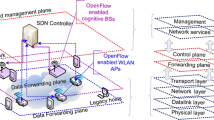Abstract
Cognitive Radio (CR) equipments are radio devices that support the smart facilities offered by future cognitive networks. Even if several categories of equipments exist (terminal, base station, smart PDA, etc.), each requiring different processing capabilities (and associated cost or power consumption), these equipments have to integrate also a set of new capabilities as regards CR support, in addition to the usual radio signal processing elements. This implies real-time radio adaptation and sensing capabilities, but not only. We assert that it is necessary to add inside the radio equipments some management facilities for that purpose, and we propose in this paper a high-level design approach for the specification of a management framework. This includes a set of designing rules, based on hierarchical units that are distributed over three levels, and the associated APIs necessary to efficiently manage CR features inside a CR equipment. The proposed architecture is called HDCRAM (Hierarchical and Distributed Cognitive Architecture Management). HDCRAM is an extension of a former hierarchical and distributed reconfiguration management (HDReM) architecture, which is derived from our previous research on Software Defined Radio (SDR). The HDCRAM adds to the HDReM’s reconfiguration management facilities the necessary new management features, which enable the support of sensing and decision making facilities. It consists in the combination of one Cognitive Radio Management Unit (CRMU) with each Reconfiguration Management Unit (ReMU) distributed within the equipment. Each of these CRMU is in charge of the capture, the interpretation and the decision making according to its own goals. In this Cognitive Radio context, the term “decision” refers to the adaptation of the radio parameters to the equipment’s environment. This paper details the HDCRAM’s management functionality and structure. Moreover, in order to facilitate the early design phase of the management specification, which is new in radio design, HDCRAM has also been modeled with a meta-programming language based on UML. But beyond the first objective of high-level specification, we have also derived a simulator from the obtained meta-model, thanks to the use of an executable language. This gives the opportunity to specify the CR needs and play a wide variety of scenarios, in order to validate the CR equipment’s design. This approach provides high-level design facilities for the specification of cognitive management APIs inside a cognitive radio equipment.











Similar content being viewed by others
References
Mitola, J., Maguire, G.: Cognitive radio: making software radios more personal, Personal Communications. IEEE [see also IEEE Wireless Communications] 6(4), 13–18 (1999)
Mitola, J.: Cognitive radio: an integrated agent architecture for software defined radio. Ph.D. Dissertation, Royal Institute of Technology, Sweden, May (2000)
Haykin, S.: Cognitive radio: brain-empowered wireless communications. IEEE J. Sel. Area. Commun. 23(5), 201–220 (2005)
Fan, W., Krunz, M., Shuguang, C.: Price-based spectrum management in cognitive radio networks. IEEE J. Sel. Top. Signal. Process. 2(1), 74–87 (2008)
Chen, G., Kotz, D.: A survey of context-aware mobile computing research, Technical Report TR2000-381, Department of Computer Science, Dartmouth College (2000)
Aarts, E., Harwig, H., Schuurmans, M.: Ambient intelligence. In: Denning, J. (ed.) The invisible future, pp. 235–250. McGraw Hill, New York (2001)
Qiu, X., Chuang, J.: Link adaptation in wireless data networks for throughput maximization under retransmissions. In: Proceedings of International Conference on Communications (ICC), Vancouver, Canada (1999)
Moy, C., El Zein, G., Citerne, J.: Performance of Hybrid Spread Spectrum DS/FH RAKE Receivers for Troposcatter Links at 5 GHz, ISSSTA’98. Sun City, South Africa, 2–4 sept (1998)
Turin, G.L.: Introduction to spread spectrum antimultipath techniques and their application to urban digital radio. Proc. IEEE. 68(3) (1980)
Sampaio, L., Kobayahi, M., Ryan, O., Debbah, M.: Vandermonde frequency division multiplexing for cognitive radios. In: 9th IEEE Workshop on Signal Processing Advances in Wireless Communications, Recife, Brazil (2008)
Cognitive radio report and order. ET Docket No. 03-108, 20 FCC Rcd 5486 (2005)
SDR report and order. ET Docket No. 00-47, 16 FCC Rcd 17373 (2001)
Unlicensed operation in the TV broadcast bands; additional spectrum for unlicensed devices below 900 MHz and in the 3 GHz band. Notice of proposed rulemaking, 19 FCC Rcd. 10018 (2004)
Pérez-Romero, J., Sallent, O., Agustí, R., Giupponi, L.: A novel on-demand cognitive pilot channel enabling dynamic spectrum allocation. IEEE Dyspan. (2007)
Mourad, A.M., Gueguen, A., Pyndiah, R.: Impact of the MC-CDMA physical layer algorithms on the downlink capacity in a multi-cellular environment. In: IEEE Vehicular Technology Conference (VTC) 2005
Debbah, M.: Mobile flexible networks: the route towards autonomic communications. IEEE J. Sel. Areas Commun. (2008) (submitted)
Lackey, R., Upmal, D.: SPEAKeasy, the military software radio. IEEE Commun. Mag. 33(5), 56–61 (1995)
Mitola, J.: The software radio. In: IEEE National Telesystems Conference, 1992. doi: 10.1109/NTC.1992.267870
Kountouris, A., Moy, C.: Reconfiguration in software radio systems. In: Second Karlsruhe Workshop on Software Radios, Karlshruhe, Germany, 20–21 March (2002)
Kountouris, A., Moy, C., Rambaud, L.: Reconfigurability: a key property in software radio systems. In: First Karlshruhe Workshop on Software Radios, Karlshruhe, Germany, 29–30 March (2000)
Jondral, F.K.: Software-defined radio-basics and evolution to cognitive radio. EURASIP J. Wirel. Commun. Netw. 3, 275–283
Reed, J.H., Woerner, B.D.: Software Radio: a modern approach to radio engineering. Prentice Hall (2002)
Joint tactical radio system (JTRS) standard modem hardware abstraction layer application program interface. Version 2.11.1, 02 May (2007)
Software communications architecture specification, JTRS standards, version 2.2.2, 15 May (2006)
Open source SCA implementation from Virginia Tech: http://ossie.mprg.org/
Brakensiek, J., Lenz, D., Wiebke, T., Gultchev, S., Tafazolli, R., Bisiaux, A., Moy, C., Kountouris, A., Halimic, M., Dolwin, C.: Management and controlling architecture in E2E reconfigurable terminals. In: Third Karlsruhe Workshop on Software Radios, WSR’04, pp 59–63. Karlshruhe, Germany, 17–18 March (2004)
Reves, X., Gelonch, A., Marojevic, V., Ferrus, R.: Software radios: unifying the reconfiguration process over heterogeneous platforms. EURASIP J. Appl. Signal Process. (16) (2005)
Delahaye, J.P., Moy, C., Leray, P., Palicot, J.: Managing dynamic partial reconfiguration on heterogeneous SDR platforms. In: SDR Forum Technical Conference, Anaheim (USA), November (2005)
Raulet, M., Urban, F., Nezan, J.F., Moy, C., Deforges, O., Sorel, Y.: Rapid prototyping for heterogeneous multicomponent systems: an MPEG-4 stream over an UMTS communication link. EURASIP J. Appl. Signal Process. (Special Issue on Design Methods for DSP Systems). Article ID 64369 (2006)
Wipliez, M., Roquier, G., Raulet, M., Nezan, J.-F., Deforges, O.: Code generation for the MPEG reconfigurable video coding framework: from CAL actions to C functions. In: Multimedia and Expo 2008, Hannover, Germany, 23–26 June (2006)
Godard, L., Moy, C., Palicot, J.: From a configuration management to a cognitive radio management of SDR systems. In: CrownCom’06, pp 11–15. Mykonos, Greece, 8–10 June (2006)
Moy, C., Bisiaux, A., Paquelet, S.: An ultra-wide band umbilical cord for cognitive radio systems. In: PIMRC’05, vol 2, pp 775–779. Berlin, September (2005)
Godard, L., Moy, C., Palicot, J.: An executable meta-model of a hierarchical and distributed architecture management for the design of cognitive radio equipments. Ann. Telecommun. 64(7/8), 463–482 (2009)
Delahaye, J.P., Leray, P., Moy, C.: Designing a reconfigurable processing datapath for sdr over heterogeneous reconfigurable platforms. In: SDR Forum Technical Conference’07, Denver (USA), 5–9 November (2007)
Hachemani, R., Palicot, J., Moy, C.: A new standard recognition sensor for cognitive radio terminal. In: EUSIPCO’07, Poznan, Pologne, 3–7 Septembre (2007)
Ghozzi, M., Dohler, M., Marx, F., Palicot, J.: Cognitive radio: methods for the detection of free bands, towards reconfigurable and cognitive communications. C. R. Physique 7(7), 794–804 (2006)
Jouini, W., Ernst, D., Moy, C., Palicot, J.: Multi-armed bandit based policies for cognitive radio’s decision making issues. In: 3rd Conference on Signal Circuits and Systems, Jerba, Tunisia, 6–8 November (2009)
OMG unified modeling language infrastructure specification, version 2.0. September 2001. Document ptc/03-09-15, available at http://www.omg.org/
PIM and PSM for software radio components, final adopted specification. dtc/04-05-04, http://www.omg.org/docs/dtc/04-05-04.pdf
Moy, C., Raulet, M., Rouxel, S., Diguet, J.-P., Gogniat, G., Desfray, P., Bulteau, N., Goubard, J.-E., Denef, Y.: UML profile for waveform SPS abstraction. In: SDR Forum Technical Conference, Phoenix, Arizona, USA, November (2004)
Rouxel, S., Diguet, J.-P., Bulteau, N., Carre-Gourding, J., Goubard, J.-E., Moy, C.: UML framework for PIM and PSM verification of SDR systems. In: SDR Forum Technical Conference’05, Anaheim, USA, November (2005)
Dekeyser, J., Boulet, P., Marquet, P., Meftali, S.: Model driven engineering for soc co-design. In: NEWCAS Conference, 2005. The 3rd International, pp 21–25 (2005)
Koudri, A., Vojtsiek, D., Soulard, P., Moy, C., Champeau, J., Vidal, J., Le lann, J.-C.: Using MARTE in a co-design methodology. In: MARTE workshop at DATE, Munchen, Germany, March (2008)
OMG. MOF 2.0 Core Final Adopted Specification, Object Management Group (2004). http://www.omg.org/cgi-bin/doc ?ptc/03-10-04
Muller, P.A., Fleurey, F., Jezequel, J.M.: Weaving executability into object-oriented metalanguages. LNCS, Montego Bay, Jamaica, MODELS/UML’2005, Springer (2005)
Godard, L., Moy, C., Palicot, J.: A simulator for the design of the management architecture of cognitive radio equipments. In: 5th Karlsruhe Workshop on Software Radios, WSR’08, Karlsruhe, Germany, March (2008)
Author information
Authors and Affiliations
Corresponding author
Rights and permissions
About this article
Cite this article
Moy, C. High-Level Design Approach for the Specification of Cognitive Radio Equipments Management APIs. J Netw Syst Manage 18, 64–96 (2010). https://doi.org/10.1007/s10922-009-9151-3
Published:
Issue Date:
DOI: https://doi.org/10.1007/s10922-009-9151-3




